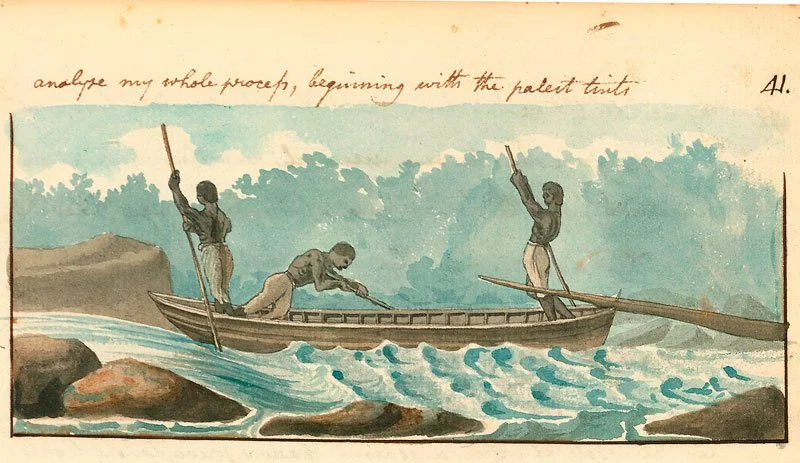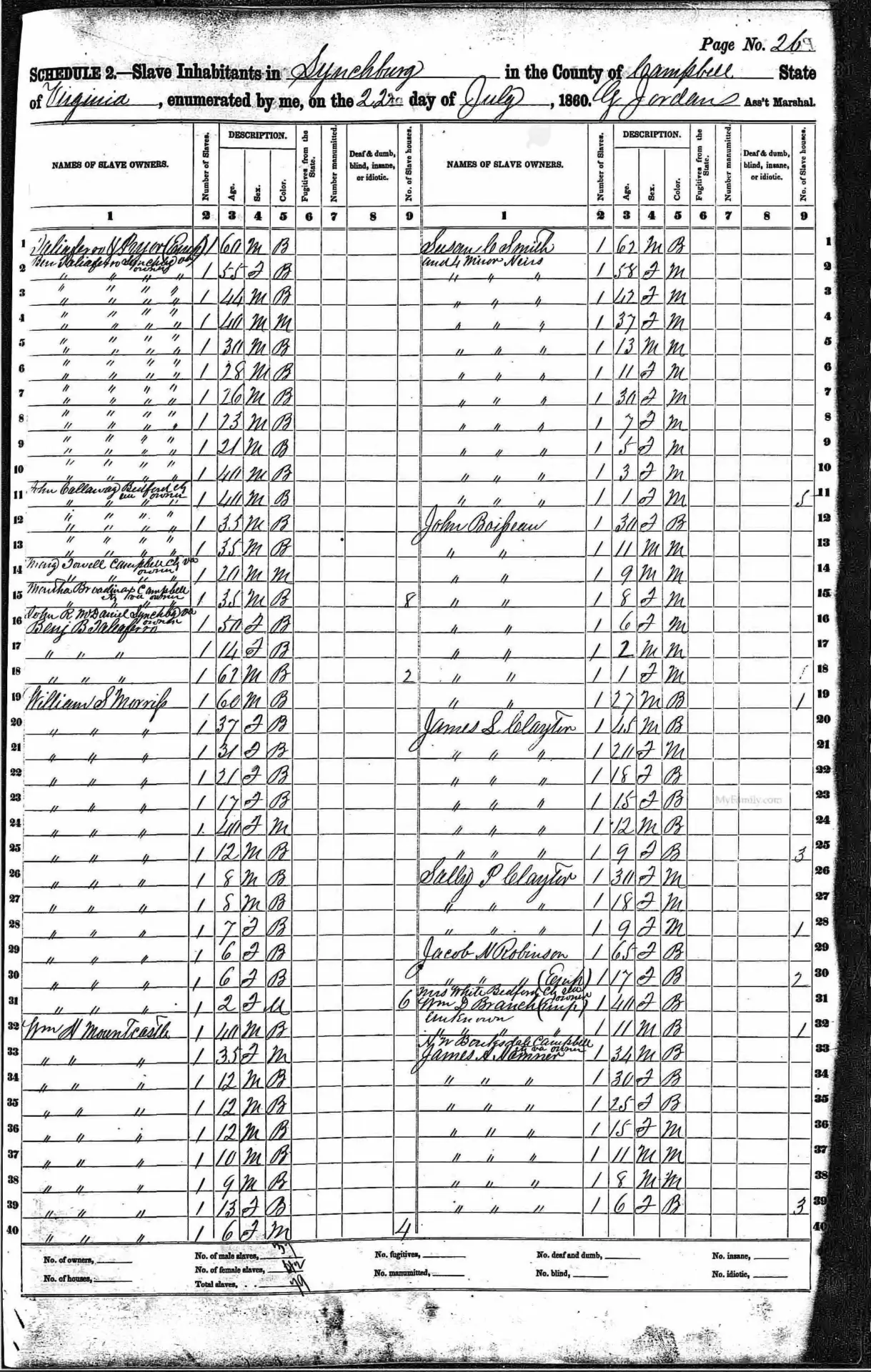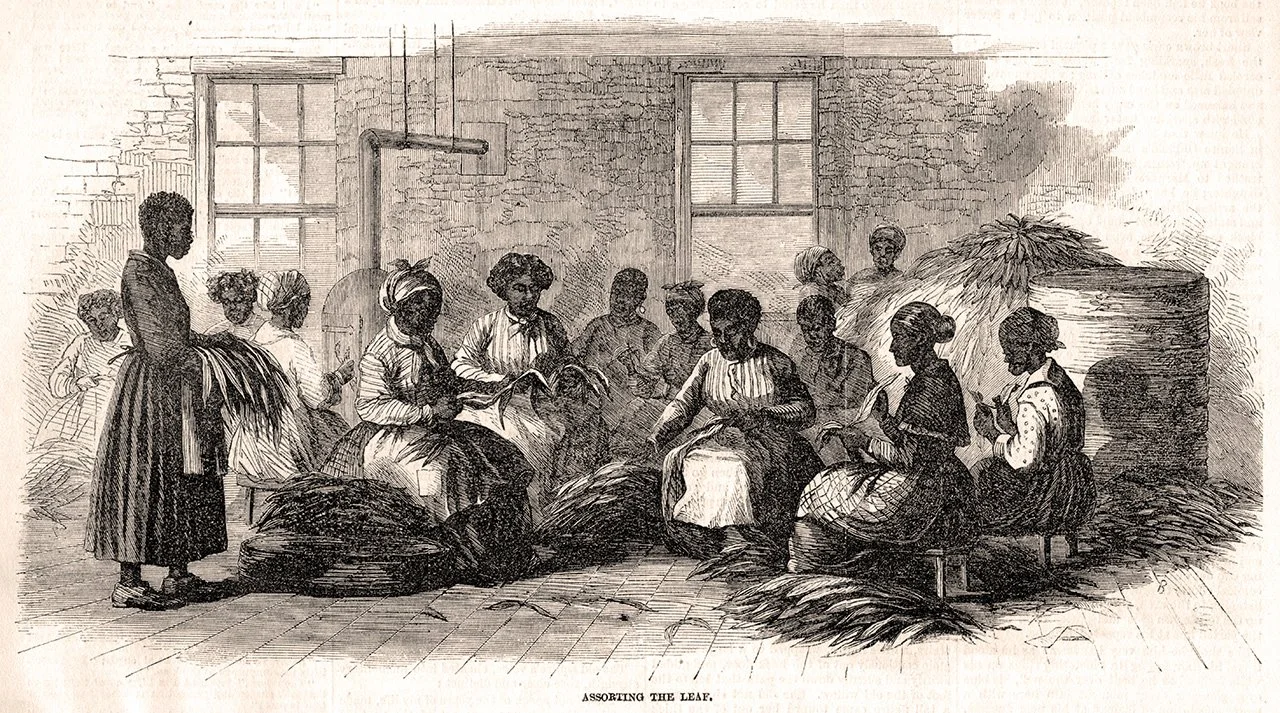The first documented enslaved people were brought to Central Virginia by European American settlers in the late 1730’s. By 1860 the city of Lynchburg was not only home to one of the largest concentrations of enslaved factory workers in Virginia, but it was also a major site for trading and auctioning enslaved people in the state.
Between 1800 and 1860, there were nearly as many enslaved and free Black residents of Lynchburg as there were White.
In 2024 six sites connected to slavery in Lynchburg were marked with an official Silent Witnesses plaque:
- Site of African Baptist Church: first independent African American congregation in Lynchburg, established in 1843
- James River & Canal: arrival and departure site for many enslaved people; also batteaux and packet boats relied heavily on enslaved and free Black labor
- Knight’s Tobacco Factory: one of last few remaining antebellum tobacco factories in Lynchburg, whose enslaved laborers brought great wealth to the Hill City in the 19th century
- Site of Leftwich’s Row: series of brick and frame dwellings for enslaved and free Black residents
- Site of Market House: location of many public slave auctions, as well as the town’s largest market for enslaved vendors and craftspeople
- Site of Woodroof’s Slave Auction & Boarding Business: most active and infamous slave trading business in Lynchburg, circa 1830-1860

Gallery of Enslaved Residents of Lynchburg

Circa 1853 Daguerrotype by Peter E. Gibbs, Courtesy of Library of Congress | Mary Brice lived and worked at the Point of Honor estate in Lynchburg in the 1850’s. Besides being one of the earliest known photographs taken in Lynchburg, this is the only identified photograph of an enslaved resident of Lynchburg taken before Emancipation. Brice likely worked in a domestic capacity–perhaps as cook, maid, and/or nurse.

Circa 1900–1910, Lynchburg Museum System Collection | Martha Spence Edley was born enslaved in Virginia in 1826. She worked as a “housemaid” for several generations of the same Lynchburg family, both before and after Emancipation. She is shown here peeling tomatoes on the porch of her employer’s residence in Rivermont. Edley died in 1920 at age 94 and was buried in Lynchburg’s Old City Cemetery with her husband and young children.

Taken by Holding & Edwards and D. C. Maxwell, both Lynchburg photographers, Circa 1865-1875, Lynchburg Museum System Collection | These three "cartes de visite" photographs were taken in Lynchburg studios between 1865 and 1875. Unfortunately, the subjects are not identified, but they can be dated by the "Holding & Edwards" and "D. C. Maxwell" Lynchburg studio marks on the reverse. The portraits show the sophistication and affluence of some African Americans in Lynchburg just after Emancipation.

Taken by Holding & Edwards and D. C. Maxwell, both Lynchburg photographers, Circa 1865-1875, Lynchburg Museum System Collection | These three "cartes de visite" photographs were taken in Lynchburg studios between 1865 and 1875. Unfortunately, the subjects are not identified, but they can be dated by the "Holding & Edwards" and "D. C. Maxwell" Lynchburg studio marks on the reverse. The portraits show the sophistication and affluence of some African Americans in Lynchburg just after Emancipation.

Taken by Holding & Edwards and D. C. Maxwell, both Lynchburg photographers, Circa 1865-1875, Lynchburg Museum System Collection | These three "cartes de visite" photographs were taken in Lynchburg studios between 1865 and 1875. Unfortunately, the subjects are not identified, but they can be dated by the "Holding & Edwards" and "D. C. Maxwell" Lynchburg studio marks on the reverse. The portraits show the sophistication and affluence of some African Americans in Lynchburg just after Emancipation.

Circa 1877-1880 Carte-de-visite Photograph by Adam H. Plecker, Courtesy of Library of Congress | Plecker’s studio was on Main Street near Ninth.
Lynchburg Market House

Circa 1873
Published in Edward King’s travelogue The Great South, published in 1875
Lynchburg Museum System Collection
This view of downtown Lynchburg shows the city’s Market House in the foreground and the Old Court House on Court Street in the distance. The Market House was located in the center of Ninth Street between Main and Church Streets. It was the site of many auctions of enslaved people before Emancipation in 1865, especially public sales ordered by the local court.
1863 Slave Auction Advertisement

Published in the Lynchburg Daily Republican
Lynchburg Museum System Collection
The Hargrove & Company slave auction and brokerage business of Lynchburg was operated by James B. Hargrove, E. P. Aistrop, and N. A. Mitchell. Their business received enslaved people for consignment and could temporarily house them until they were sold or rented. The main office was located on Ninth Street (then called “Bridge Street”).
Despondent over the demise of his business after the end of the Civil War and Emancipation, Hargrove committed suicide in Lynchburg in July 1865.
“Steering a Bateau”

Watercolor by Benjamin Henry Latrobe, 1798
From An Essay on Landscape, 1798–1799, Accession 25060, Personal Papers Collection, Library of Virginia
In this watercolor painting, Latrobe depicts three Black men, who were likely enslaved, directing a bateau through the rapids of the James River at Richmond. These long flat-bottomed boats were used to carry goods such as tobacco and coal along rivers and canals as late as the 20th century. Between the 1770s and the 1840s, hundreds of men operated such boats along the James River between Lynchburg and Richmond. In the journal entry that accompanied this illustration, Latrobe noted that it was inaccurate. The boat he painted was “too short: they are from 60 to 75 feet long, & from 5 to 6 feet broad.” He went on to describe that each bateau (sometimes spelled batteau) was “managed by 3 Men,” one to steer while the other two poled, and “who with great dexterity often carry them 30 miles against the stream in one day.” Batteaux poled and steered by enslaved men were common sights in Lynchburg, which was connected to Richmond by the James River.
1860 Census Slave Schedule

Sample page from 1860 Federal Census Slave Schedule for Lynchburg, Virginia
Courtesy of Ancestry.com, provided in association with National Archives and Records Administration
This page shows how enslaved people were recorded in the 1860 federal census: not by name, but only by age, gender, skin color, and enslaver or employer. This particular page shows both men and women enslavers, as well as several citizens who rented (but did not own) slaves. They are designated by the notation “Emp” for “Employer.”
William H. Mountcastle (shown as enslaving nine people including seven children) was a Lynchburg “Negro trader” who regularly advertised in local newspapers. William D. Branch was Lynchburg’s long-time mayor from 1851 to 1869.
Sorting Leaves in Lynchburg Tobacco Factory

Circa 1866
Published in Frank Leslie’s Illustrated Newspaper, July 7, 1866, p. 248
Lynchburg Museum System Collection
This engraving depicts Black women sorting tobacco leaves in a Lynchburg factory one year after Emancipation. The Hill City was a nationally recognized producer of “plug” or chewing tobacco throughout the 19th century. Virtually all of the laborers in these factories—both before and after the Civil War—were Black men, women, and children. Their labor fueled Lynchburg’s economy and made many of its tobacconists very wealthy.
Lynchburg “Slave Prison”

Circa 1930’s
Lynchburg Museum System Collection
The label on this photograph suggests there was an old slave “prison” or jail on Horseford Road in downtown Lynchburg. The structure was supposedly built in the 18th century and demolished in 1933. Neither the location nor the owner has been confirmed.
Receipt for Purchase of Jacob

October 25, 1862
Lynchburg Museum System Collection
This pre-printed receipt was filled out for the sale of “one negro slave named Jacob” from William Wise to prominent Lynchburg tobacconist Maurice Moore (recorded here as “Morris Moore”). The sale price was $1,400. The receipt attests that Jacob was “sound and healthy.” Wise’s residence and occupation are unknown.
Scene in Lynchburg Tobacco Factory

Circa 1873
Published in Edward King’s travelogue The Great South, published in 1875
Lynchburg Museum System Collection
“The men and women working around the tables in the basements of the Lynchburg tobacco establishments croon eccentric hymns in concert all day long; and their little children, laboring before they are hardly large enough to go alone, join in the refrains. Tobacco is the main article of Lynchburg trade. Buyers from all parts of the Union crowd the streets; the warehouses are daily visited by throngs.”


